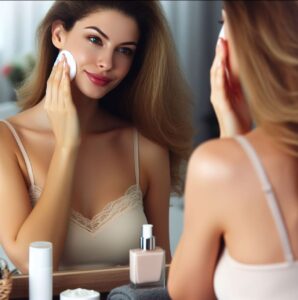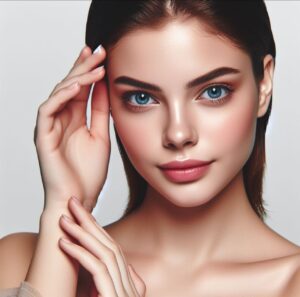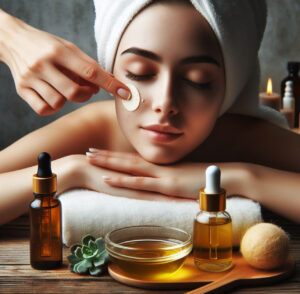
Skin Care Routine
Have you ever been asked, if you have any skincare tips because your skin glows? How do you choose the skincare routine for your skin type and age? Skincare is not a one-size-fits-all affair. Your skin type, age, and other factors can affect what products and ingredients work best for you. Choosing a skincare routine can help you achieve a healthy, youthful complexion. But how do you know what skincare routine is perfect for you? Below are some tips and guidelines to help you find your match.

Know Your Skin Type
The first step is to know your skin type. Each skin type has different characteristics, needs, and challenges.
a. Normal skin is well-balanced, with a smooth texture and no visible blemishes or signs of sensitivity. Thus, it can tolerate most products and ingredients but needs proper cleansing, moisturizing, and sun protection to maintain health and appearance.
b. Oily skin produces excess sebum (oil), which can cause acne, blackheads, and enlarged pores. It can also look shiny and greasy throughout the day. This skin type needs gentle cleansing, oil-free moisturizing, and mattifying products to control shine and prevent breakouts.
c. Dry skin lacks moisture and natural oils that feel tight, rough, flaky, and dull. It can also be prone to irritation, redness, and sensitivity. Dry skin needs gentle cleansing, moisturizing, and nourishing products to restore moisture and comfort.
d. Combination skin has both oily and dry areas, usually with an oily T-zone (forehead, nose, and chin) and dry cheeks. It can be tricky to care for, as it needs different products for different areas. This skin type needs gentle cleansing, balancing moisturizing, and targeted products to address specific concerns.
e. Acne-prone skin/ sensitive skin reacts to products, ingredients, or environmental factors, causing itching, burning, stinging, or rashes. It is prone to developing pimples, cysts, or nodules due to hormonal changes, stress, diet, or other factors. This skin type needs gentle cleansing, oil-free moisturizing, and anti-acne products to treat and prevent blemishes.
How to Know Your Skin Type?

To know your skin type, do this simple test at home:
- Rinse your face with a gentle cleanser and pat it dry.
- Wait for an hour and then observe your skin in a mirror. If you have dry skin, it feels tight and looks dull or flaky. In addition, if it looks shiny and feels greasy, it is oily.
- The skin that looks shiny on the T-zone and dries on the cheeks, you have a combination type of skin.
- If it looks smooth and even, you have normal skin.
Know Your Age
The second step to choosing the skincare routine is to know your age. Undoubtedly, your skin changes as you age, and so do its needs and concerns. Some general guidelines for different age groups are:
a. Teens: Teenage skin is often oily and acne-prone due to hormonal changes. Teens need a simple skincare routine on cleansing, moisturizing, and sun protection. Also, they should use products that treat and prevent acne.
b. The 20s: In your 20s, your skin is still young and resilient, but it may start to show some signs of aging, such as fine lines, dark spots, or dullness. You need a skincare routine that maintains your skin’s health and prevents premature aging. As well as that, use products that contain antioxidants, vitamin C, or retinol to boost collagen production and brighten your complexion.
c. 30s: In your 30s, your skin starts to lose some elasticity and firmness due to a decline in collagen and elastin production. You may also notice more visible signs of aging, such as wrinkles, sagging, or hyperpigmentation. With that, do a skincare routine that repairs your skin’s damage and restores its youthfulness. In this case, you should use products that contain peptides, hyaluronic acid, or alpha hydroxy acids to plump up your skin and smooth out fine lines.
d. The 40s: in your 40s, not only does your skin become thinner and drier due to less sebum production and moisture retention, but you may also experience more hormonal changes that affect your skin’s balance and appearance. Therefore, you should have a skincare routine that shields your skin from environmental stressors. Moreover, use products that contain ceramides, niacinamide, or retinoids to strengthen your skin’s barrier and stimulate cell renewal.
e. 50s+: In your 50s and beyond, skin becomes more fragile and sensitive due to less fat and muscle tissue. Unquestionably, you may experience more menopausal symptoms that can cause hot flashes, dryness, or redness. In this case, having a skincare routine nourishes your skin and soothes discomfort. You should also use products that contain growth factors, stem cells, and use products that contain growth factors, stem cells, or phytoestrogens to replenish your skin’s vitality and density.
Know Your Routine
The third step is to know your routine. Your skincare routine should consist of three basic steps: cleansing, treating, and moisturizing. Some examples of skincare routines for different scenarios are:
a. Oily and acne-prone skin in your 20s:
Morning:
- Firstly, cleanse with a gentle foaming cleanser to remove excess oil and bacteria.
- Secondly, treat with a lightweight serum that contains vitamin C or niacinamide to brighten your skin and reduce inflammation.
- Then, moisturize with an oil-free gel or lotion that contains hyaluronic acid or aloe vera to hydrate your skin without clogging your pores.
- Lastly, protect with a broad-spectrum sunscreen that has at least SPF 30 and is non-comedogenic (won’t cause breakouts).
Night:
- First, cleanse with the same cleanser as in the morning or use micellar water to remove makeup and impurities.
- Then, treat with a spot treatment with contents that target and heal any blemishes.
- Lastly, moisturize with the same moisturizer as in the morning, or use a night cream that contains retinol or alpha hydroxy acids to exfoliate and smooth your skin.
b. Dry and sensitive skin in your 40s:
Morning:
- Firstly, cleanse with a gentle cream or milk cleanser that contains ceramides or glycerin to cleanse and moisturize your skin.
- Then, treat with a soothing serum with peptides, hyaluronic acid, or chamomile to plump up your skin and calm irritation.
- Next, moisturize with a rich cream or balm that contains shea butter, jojoba oil, or squalane to nourish and protect your skin.
- Finally, protect with a broad-spectrum sunscreen that has at least SPF 30 and is fragrance-free and hypoallergenic.
Night:
- First, cleanse with the same cleanser as in the morning or use an oil-based cleanser to remove makeup and impurities.
- Next, treat with a nourishing serum that contains growth factors, stem cells, or phytoestrogens to replenish your skin’s vitality and density.
- Finally, moisturize with the same moisturizer as in the morning, or use a night cream that contains retinoids or alpha hydroxy acids to stimulate cell renewal and smooth out fine lines.
c. Mixed type and normal skin in your 30s:
Morning:
- Firstly, cleanse with a gentle gel or foam cleanser that contains alpha hydroxy acids or enzymes to cleanse and exfoliate your skin.
- Next, Treat with a hydrating serum that contains hyaluronic acid, vitamin C, or antioxidants to moisturize and brighten your skin.
- Then, moisturize with a lightweight cream or lotion that contains ceramides, niacinamide, or SPF to balance and protect your skin.
- Lastly, protect with a broad-spectrum sunscreen that has at least SPF 30 and is suitable for your skin type.
Night:
- Firstly, cleanse with the same cleanser as in the morning or use a cleansing balm to remove makeup and impurities.
- Secondly, treat with a rejuvenating serum that contains retinol, peptides, or alpha hydroxy acids to repair and restore your skin.
- Finally, moisturize with the same moisturizer as in the morning, or use a night cream that contains shea butter, jojoba oil, or squalane to nourish and seal in moisture.

These are just some skincare routines for different skin types and ages. You can change it based on your preferences, budget, and availability of products. The most important thing is to pick items that work for your skin type and address your concerns. Also, be consistent with your routine and give it time to work to achieve a healthy and youthful complexion. Thanks for reading, and I’ll see you in the next one.



